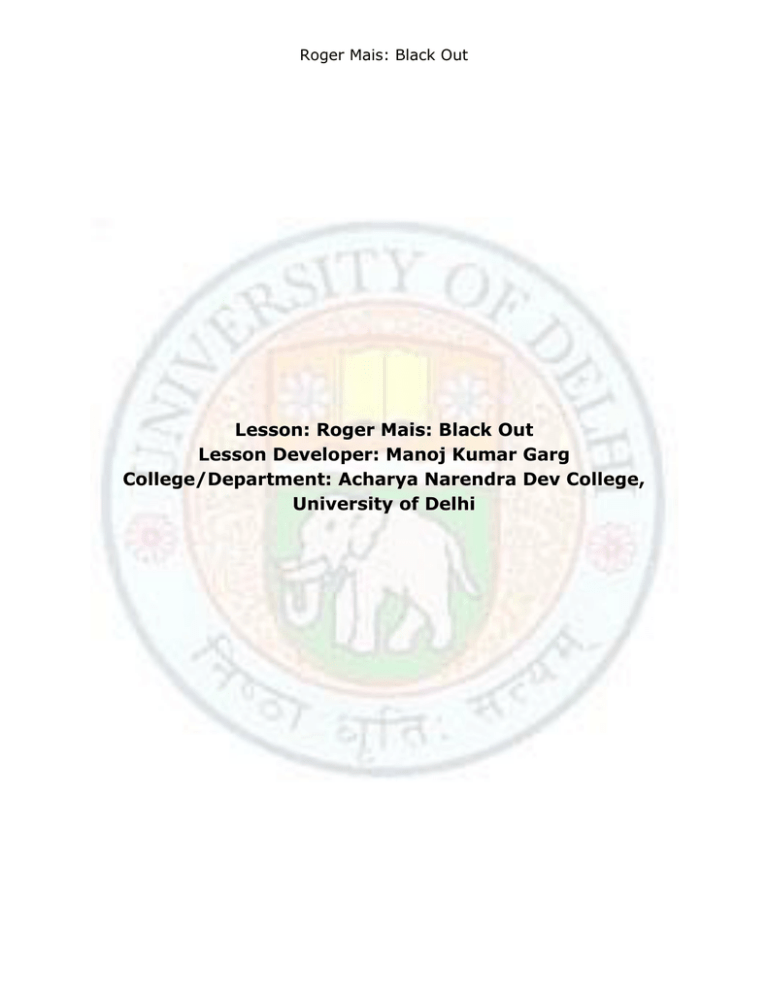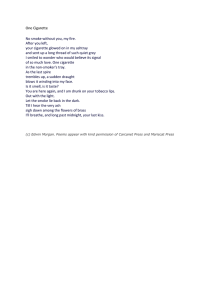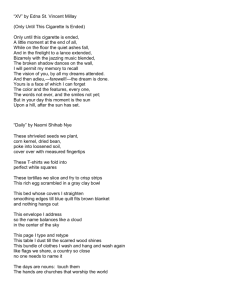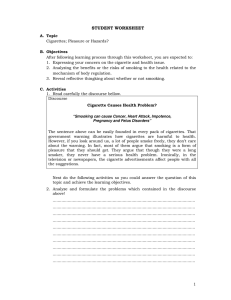Lesson: Roger Mais: Black Out Lesson Developer: Manoj Kumar
advertisement

Roger Mais: Black Out Lesson: Roger Mais: Black Out Lesson Developer: Manoj Kumar Garg College/Department: Acharya Narendra Dev College, University of Delhi Roger Mais: Black Out Roger Mais: Black Out Roger Mais Journalist Roger Mais was a Jamaican journalist, novelist, poet, and playwright. He was born to a middle-class family in Kingston, Jamaica. By 1951, he had won ten first prizes in West Indian literary competitions Born: August 11, 1905, Kingston, Jamaica Education: Calabar High School Books: Brother Man, Listen, the wind, Black Lightning, The Hills Were Joyful Together Roger Mais, the Jamaican novelist, poet, playwright and journalist, was born on 11 August 1905 in Kingston, Jamaica. He belonged to an educated middle class family. He spent his boyhood in the Blue Mountains region where his father took up farming. His early education was made at home and was sent to Calabar High School, Kingston, for further education. In his early days, he worked as an Office worker, an insurance salesman, an overseer at a banana plantation, a photographer, and a journalist. He worked as a journalist for The Gleaner and Public Opinion, for which he wrote a number of articles. He concerned his articles with inequality and social injustice. He also wrote a number of plays, short stories and reviews. He wrote more than thirty stage and radio plays, and published more than one hundred short stories. He left Jamaica for the UK in 1952. During his stay, he lived in London, Paris and the southern part of France. In 1954, he discovered that he had terminal cancer and returned back to Jamaica. 21 June 1955 was the day when he left this world. Roger Mais: Black Out Political Involvement Most of the works of Mais have political undertone to some degree. His major concerns were inequality, social injustice and colonialism. He illustrated poverty to the full extent. His works have been described as ‘propaganda’. He denounced England for exploitation and enslaving, especially Winston Churchill for ‘hypocrisy’ and ‘deception’. As a consequence, he was charged with sedition and sentenced to a six-month prison. In 1938, major riots broke out all throughout the Caribbean islands. Mais volunteered himself to help to quell the riots at Kingston where there was a change of his heart. He appeared with totally changed mindset and took the side of the workers who were rioting. He became a wholly committed supporter and activist involved with the People’s National Party and Jamaican nationalism. He decided to direct and push for the political and social change. In 1939, he started his journalistic career as a contributor with the left-wing political weekly newspaper Public Opinion and worked upto 1952, before he left for England. The paper was associated with ‘People’s National Party. He worked to build a ‘national identity’. He focused on local language and culture. His characters spoke in local West Indian dialect which helped him to connect with the local audience. He was awarded the high honour of the ‘Order of Jamaica’, in 1978, for his integral role in the development of ‘political and cultural nationalism’.1 Awards Mais has been awarded: Musgrave Gold Medal in 1968. The Order of Jamaica in 1978.2 Ten first prizes in West Indian literary competitions.3 Works Roger Mais: Black Out Mais has written three novels, several plays, short stories and articles. His novels have been republished posthumously several times which indicates his importance to the Caribbean literary history. Many of his manuscripts have been deposited in the library of University of West Indies, Jamaica.4 His works include: NovelsThe Hills Were Joyful Together (1953) Brother Man (1954) Black Lightning (1955) Roger Mais: Black Out Plays- Before 1930, in West Indies, plays were based on Europe with European actors. Shows consisted of Shakespearian plays, but progress was being made to introduce the plays that may depict the Caribbean life and history. Mais wrote more than thirty stage and radio plays. His play, George William Gordon, published in 1940s, represents not only the people but also shows their cries. The unfair court system, the low wages and their repercussions are stated in the play. Some other plays areMasks and Paper Hats (1943) Hurricane (1950) The Potter's Field (1950) The First Sacrifice (1956) He also wrote a number of articles. In 1944, he wrote the anti-British satirical tirade Now We Know, criticizing the British colonial rule, for which he was sentenced to six months' imprisonment for sedition.5 He also wrote another article, Why I Love and Leave Jamaica, in 1950, which stirred emotions of the people. Short Stories- Mais wrote more than one hundred short stories. Most of them were published in two journalistic publications, Public Opinion and Focus. He also published two collections, Face and Other Stories, and And Most of All Man. His short stories were collected in a volume entitled Listen, The Wind, thirty-two years after his death. BLACK OUT Roger Mais: Black Out Black Out is a short story written by Roger Mais. The story is focused on social injustice and inequality. Story aims at the differences between two races, genders and cultures. The setting is on Jamaica, one of the tropical islands of the West Indies, during the Second World War (19391945). The story describes an encounter between a Black West Indian man and an American girl. At that time, the Blacks were segregated in American society. There were separate schools, buses and restaurants for Blacks and Whites. Lynching of Negroes was common, especially in the southern states of America. Roger Mais: Black Out Author’s Objective Roger Mais was born and brought up in Jamaica. It is a tropical island in West Indies where Black men and women reside. At that time, Blacks were treated as inferior to Whites. They were imported as slaves from Africa and other countries. They were denied freedom and equality by the Whites. The objective of the author, in this story, is to highlight the racial segregation in the American society. Through the American woman, he highlights the racist attitude of Americans. The polite and gentle behavior of the Black man shakes the supreme confidence in racial supremacy of the woman. He becomes able to put forth his point of view that all men and women are equal. There are only two races in the World that God originally created – men and women. Summary A young American woman was waiting at the bus stop. It was wartime and there was blackout in the city. The street lights had not been turned on in order to conserve electricity. The houses in the locality were hidden behind their ‘ourelia’ hedges. There were the rumours that the bands of hooligans had been moving about in the streets after darkness, attacking and molesting the unprotected women. But she was neither nervous nor scared as she knew that if she may shout, the nearby residents may come to her help. Moreover she was an American and was fully conscious that American women do not scare easily. She was smoking a cigarette. Suddenly she saw the shadow of a Black young man who was slowly moving towards her. She was not moved at all. The man was very tall. He was dressed in conventional shirt and pants, and was wearing a pair of canvas shoes. There was a curious look of hunger and unrest in his eyes. She was not bothered about his appearance but noticed only that he was a Black. She was not afraid of him. She knew that, in her country, a Black man cannot approach a White woman so casually. She was curious to find out what this man wanted from her. She was thinking that it would be a new experience to narrate when she would return back home. Roger Mais: Black Out The young man approached her and politely asked for a light. He wanted to light his cigarette. She was smoking but she did not have the matches on her. She had lit her cigarette from the stub of the cigarette she had thrown away. She wondered whether he would believe her or not. She replied him that she did not have the matches on her. The man was surprised at the answer. He kept looking hard at her face. There was pride and challenge in his look. He asked her that she was smoking herself. There was no argument against that. Actually, she was not willing to give her cigarette to light his cigarette because he was a Black. That would have suggested a certain degree of closeness which she did not want. Hesitantly, she held out her cigarette towards him between her two fingers. She was thinking that he would take it from her hand, light his cigarette, and return her back. Instead of taking the cigarette from her hand, he simply bent over her hand to light his cigarette. He did not understand that she meant him to take the lighted cigarette from her hand. In the process, he came quite close to her. She noticed that the man was smoking the half of a cigarette, holding tight in his hand; the other half would have been saved to smoke later. Thereafter, he straightened up, inhaled a deep lungful of soothing smoke and exhaled again with satisfaction. He thanked the lady politely. When he turned to move off, he was surprised to notice that instead of returning the cigarette to her lips, she threw it away into a nearby gutter. He stood there, looking at her, trying to guess her motive. It unnerved the young lady. It was not that she was frightened but his contemptuous look made her feel uncomfortable. In order to break the tension, she asked him what he was waiting for. The man regretted to make her waste the whole cigarette. She answered that she has plenty more where that came from. She did not want to indulge in free talk with a Black man, at a public street. She found it indecent. She was thinking why he doesn’t move on. He read her thoughts and said, “It’s a public street.” The lady did not think it proper to answer. The man uttered, “It’s a good thing you’re a woman”. The lady said, “If I were a man?” The man cleverly replied that then he would have treated differently and would have told her about her superior behaviour in a manner she would understand easily. She was thinking that he had been lynched in America for this. The man read her thoughts and told her that it wasn’t America where a Black would be hanged to death for a minor offence. There was no racial segregation and there were only men and women in his country. She could do nothing except listening to him but his attitude baffled her. Roger Mais: Black Out In the meantime, the bus arrived. He thanked the lady for light as a matter of courtesy. She replied not to mention with a nervous laugh. The lady boarded the bus. The man kept standing there as he was conscious of his male strength and pride. As the bus moved off, she was conscious of the quiet scrutiny of his eyes. There was something in him which was challenging and disturbing. He had shaken her supreme confidence of being a White woman who looks down upon the Blacks. She was curious to take a last look at him but she decided against it. Perhaps, she did not want the fellow passengers to notice her looking back at a Black man. It was good that she did not see him, retrieving the half smoked cigarette which she had thrown away, from the gutter. Analysis The story is set in Jamaica and is about racism. It contrasts two races, sexes, classes and cultures. There are two characters in the story- a female American and a Black Jamaican man. The conversation, between the two, shows the difference between two races, genders and cultures. The woman is full of racial biasness. She considers Blacks as untouchables. When the man lights his cigarette from her cigarette, instead of smoking again, she flicks it away. She does so because she was disgusted that a Black man had touched the cigarette. When the man apologizes for her action, she feels indecent talking to a Black man. Then the conversation focuses on gender and race which shows that the woman had the racist thoughts. She is also proud of her class. The American woman is rich whereas the man is poor. The man was smoking half of the cigarette and the other half was preserved for future consumption. When the man regrets to make her waste the whole cigarette, she answers that she has plenty more where that came from, which shows her social status. In terms of gender, one is a man the other a woman. Both are proud of their genders. The woman was proud of her being an American woman whereas the man was proud of his male strength. At the end of the story, they start reacting to each other as ‘any man any woman’. The story also denotes the difference between the two cultures. In America, a Black person can’t approach a white woman nonchalantly but in West Indies, as the man tells her, there are only men and women in this country. There was no segregation and all were treated equally. Roger Mais: Black Out Lynching of Negroes was common in America. They were even lynched for a slightest offence which reflects the difference of two cultures. The young woman was intrigued at the approach of the young man because he was moving quietly and stealthily towards her. Unlike the Negroes in America, he was polite and civilized. She was used to the rude and insolent attitude of the Negroes in America. He requests her for a light. He behaved decently while she was not expecting such behavior from a Black man. She was surprised and baffled at the approach of the man. When she throws the cigarette away, he coolly observes her. His quiet contemptuous look made her quite uncomfortable. He tells her that there is no discrimination over the color and class in West Indies. They are treated as only men and women in our country and you will learn from your experience. On the other hand, the woman is a firm believer in color and class because she had observed the treatment with Negroes in her country. She views the man through her racial perspective. She does not believe that all men and women are equal. The man does not misbehave with her. He puts his point of view dispassionately that they are man and woman. But as the lady stays longer with the Black young man, she secretly starts admiring his views. Her attitude gets changed after the conversation. In the bus, she urges to have a last look at the man but she decides against it because she did not want the fellow passengers to notice her looking back at the black man. Perhaps it was better for her as she did not see the man bending down and taking out the half-smoked cigarette she had thrown away in the gutter. Racial segregation was still practiced in America at that time. The Negroes were considered as inferior to the White Americans. The woman’s supreme confidence was in her racial superiority. She had heard of Negroes assaulting and molesting lonely women in America. She didn’t have good reputation for Negroes but this Black young man turned out to be different. He behaved gently and politely. He tells her that there are hundreds and thousands like him in West Indies. He tells her that she has no right to look down upon him as she is not in America. He puts his point of view dispassionately that all men and women are equal and are the creation of God. His politeness and pride shake the Women’s ‘supreme confidence’ in her racial superiority and at the end, she starts considering him as a human being, not as black man. Roger Mais: Black Out Cigarette is the pivot on which the whole story revolves. The occasional references to cigarette help a lot to structure the story. The story begins with the man requesting the American woman for a light. He wanted to light his cigarette. He had assumed that she would have a match-stick with her, as she was smoking the cigarette. But she had no light. She had lit her cigarette from the stub of the cigarette she had been smoking earlier. She didn’t want to offer her own cigarette to light his cigarette because she thinks that it may lead to closeness and intimacy with the young man. With slight hesitation, she held out her cigarette towards him between her two fingers. Instead of taking the cigarette from her hand, he bends down and lights his own cigarette from hers. But the woman, unconsciously, throws away her cigarette which she had been enjoying a moment earlier because a Black man had touched the cigarette. This shows the racist attitude of the woman. Smoking of cigarettes by the American lady proves that the American society is quite liberal, as far as both the sexes are concerned. It appears that she was smoking a high quality cigarette which reflects her class. On the other hand, the man was smoking the half of a cigarette and the other half might have been clinched and saved for future consumption. It reflects that the man belonged to a poor class. As the American woman boards the bus and the bus starts moving, the Black young man bends down and takes out the half-smoked cigarette the woman had thrown away from the gutter. The woman was smoking the cigarette with evident enjoyment but there was a curious look of hunger and unrest in the eyes of the man. But the American society, as it proclaims, is not liberal. There is discrimination over the color in the society. Blacks are considered inferior to Whites. They are denied the human rights and equality. They are even lynched and hanged to death for minor offences. The title ‘Blackout’ is very much apt. The story starts off explaining the partial blackout in the city. The darkness and loneliness describe the uncomfortable and tense atmosphere over the city. The phrases such as, wave of panic; bands of hooligans roaming the streets after dark and assaulting unprotected women; slinking black shadow; create a feeling of menace and threat. The darkness prevails not only over the city but also in the mind of the lady. She thinks that Whites are superior to Blacks. She hates the Blacks. As the author describes, the houses were wrapped in an atmosphere of exclusive respectability in the darkness, behind their discreet Aurelia hedges, the Black man was also standing with pride. He was able to shake the supreme confidence of the lady. Roger Mais: Black Out Racism Race is a significant social issue because people use racial differences as the basis for discrimination. Racism exists when one ethnic group dominates the other on the basis of hereditary and unalterable differences like, body structure, color of skin, and so on. Racism is the systematic practice of denying the people access to their liberty, rights and representation because of the racial difference. Mainly, racism affects people of color. It is a particular form of oppression. Much of today's racism can be traced to the era of colonialism that began in the 1400s. When Europeans began colonizing Africa and the Americas, the white settlers started to consider themselves superior to other races. It resulted in White supremacy. Blacks were the most sufferers. They were slaved and used to serve the White families. They were treated horribly. They had to suffer violence, mistreatment and degradation at the hands of Whites. They worked all day and night, cleaning and taking on commands of their masters. If they disobeyed the commands or did something wrong, they were beaten and whipped mercilessly by their masters. In the 19th century, overt racism was everywhere in America. Racism was worse during this time than at any period. Racial discrimination, segregation and white supremacy were at top. Blacks were treated as second class citizens. They were assumed to be aggressive, dangerous and up to no good. Anti-black violence, race riots, and lynching were common, especially in the southern states of America. No Black could dare to talk to any White lady. Blacks were lynched or tortured to death even at the slightest offence. Slavery was a major part of society. The society was segregated with separate buses, schools and restaurants for the Whites and Blacks. Roger Mais: Black Out Glossary Wave of panic: A feeling of fear and anxiety Sweeping the city: Spreading all over the city Bands of hooligans: Groups of anti-social elements Score of respectable suburban householders: A number of residents, residing in nearby houses Slinking black shadow: The shadow formed by the movement of a Black man Seemed to be materializing: Appearing Mere suggestion of a stoop: Seemed as the man was bent forward Dispassionate appraisement: objective assessment Questions 1. Why was city in partial blackout? 2. What was the young woman doing at the bus stop? 3. In spite of the wave of panic, why was the young woman not in the least nervous? 4. What was the slinking black shadow? 5. Why did the slinking shadow not disconcert the young woman? 6. Why was the young woman curious? 7. Describe the black man. 8. Which feature of the man did draw the attention of the young woman? Roger Mais: Black Out 9. What was the difference between America and the West Indian island? 10. What did the man ask from the white lady? What was lady’s reply? 11. Why was the lady not willing to give a light to the man? 12. In what way did the man accept the light? 13. Why was the man smoking the half of a cigarette? 14. Why did the lady throw the cigarette away? 15. Why did the man make the lady feel uncomfortable? 16. What does the man mean by “In this country there are only men and women”? 17. What did the lady do in the bus? 18. What did the man do when the lady boarded the bus? 19. What was the impact of the man’s behaviour on the lady? 20. Why does the approach of the man intrigue the American lady? 21. Why does man’s quietness disturb the lady more than rudeness would have done? 22. The American woman had a typical racist attitude in the story. Do you agree? 23. What was there in the young man which was challenging and disturbing? 24. What had been the basis of lady’s ‘supreme confidence'? How was the man able to shake it? Roger Mais: Black Out 25. How do the references to cigarettes function to structure the story? 26. In what ways do the race, class and gender affect the balance of power between the two persons, in the story? Works Cited: 1. Sood, Vinay, et al, The Individual Society, New Delhi: Pearson, 2011. 2. HTTP://en. wikipedia.org/wiki/Roger_Mais, (25 April 2014). References 1 Hawthorne, Evelyn J. "The Writer and the Nationalist Model", Roger Mais and the Decolonization of Caribbean Culture, NY: Peter Lang, 1989, p. 4. 2 Hawthorne, p. 4. 3 Hawthorne, p. 7. 4 Michael Hughes, A Companion to West Indian Literature, Collins, 1979, pp. 83-85. 5 Howard Campbell, "Icon: Roger Mais - The visionary behind classic Brother Man”, Jamaica Gleaner, 17 April 2007.


